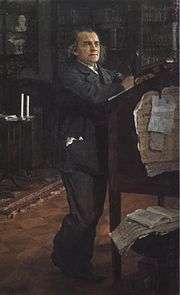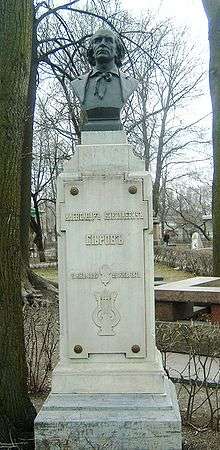Alexander Serov

Alexander Nikolayevich Serov (Russian: Алекса́ндр Никола́евич Серо́в, Saint Petersburg, 23 January [O.S. 11 January] 1820 – Saint Petersburg, 1 February [O.S. 20 January] 1871) was a Russian composer and music critic. He is notable as one of the most important music critics in Russia during the 1850s and 1860s and as the most significant Russian composer in the period between Dargomyzhsky's Rusalka and the works of Rimsky-Korsakov, Mussorgsky, and Tchaikovsky.
Alexander Serov was the father of Russian artist Valentin Serov.
Biography

Alexander Serov was born in St. Petersburg on January 11, 1820, the son of Nikolai Ivanovich Serov, a Finance Ministry official.[1] Serov's maternal grandfather, Carl Ludwig Hablitz,[2][3] was a naturalist of German-Jewish origin who was born in Königsberg and moved from to Russia in childhood when his father was hired to be inspector of Moscow University's printing department. In Russia, Hablitz became a member of the Russian Academy of Sciences among other high official posts. Serov's father Nikolai wanted him to become a lawyer as well and enrolled him in the inaugural class of the Imperial School of Jurisprudence.[1] Serov was more interested in music, however, and became a friend of another law school student, Vladimir Stasov,[1][2][4] who eventually became a famous art critic.[5]
Serov completed his studies in 1840 and started working as a lawyer in the government bureaucracy in St. Petersburg as well as in Simferopol, capital of Crimea. Eventually, his interest in music prevailed, and in 1850 he quit his job and began to compose music and to write music journalism. He also gave music lectures, though neither activity provided well for him financially.[2] In 1863 Alexander Serov married his student Valentina Serova (born Bergman), who also went on to become a composer. In 1865 a son, Valentin Serov (19 January 1865 – 5 December 1911), was born to them. He became a distinguished painter, and one of the premier Russian portrait artists of his era. Among his notable paintings were Girl with Peaches (1887), and The Girl Covered by the Sun (1888), both in the Tretyakov Gallery, and many portraits of famous people.
In 1871, Alexander Serov unexpectedly died of a heart attack. His widow finished his last opera and promoted his legacy.
As a composer, Serov is notable for composing operas. His first opera, Judith, was first performed in 1863. Although Serov's operas Judith and Rogneda were quite successful at the time, none of his operas is performed today.[6] A CD recording of Judith (with some cuts) was made in 1991 by the orchestra and choir of the Bolshoi Theatre under conductor Andrey Chistiakov.
Whereas Serov was an acclaimed critic and composer, his relations with fellow intellectuals were sometimes far from ideal. For example, he and Stasov became enemies over the relative values of Glinka's two operas.[2] Serov's admiration for Richard Wagner likewise did not endear him to The Mighty Handful, then a rising group of Russian composers, mainly due to efforts of the younger competing critic César Cui, who, like Stasov, had been on better terms with Serov earlier.[2]
Operas
- Judith (Юдифь, 1861–63)
- Rogneda (Рогнеда, 1863–65)
- The Power of the Fiend (Вражья сила, 1867–71)
References
Notes
- 1 2 3 Назаров, А. Александр Николаевич Серов (in Russian). Belcanto.ru. Retrieved 17 March 2013.
- 1 2 3 4 5 "Александр Серов (Alexander Serov)" (in Russian). Классическая музыка. Retrieved 17 March 2013.
- ↑ Габлиц, Карл Иванович (in Russian). Great Encyclopedic Dictionary. 2000. Retrieved 17 March 2013.
- ↑ Юдифь (in Russian). Библейский сюжет. Retrieved 17 March 2013.
- ↑ Maes, Francis (2002). Geschiedenis van de Russiche muziek. University of California Press. p. 40. ISBN 0520218159.
- ↑ Apel, Willi (1969). Harvard dictionary of music. Harvard University Press. p. 745. ISBN 0674375017.
Sources
- du Quenoy, Paul. Alexander Serov and the Birth of the Russian Modern. Academica Press, 2016.
- Taruskin, Richard. Opera and Drama in Russia As Preached and Practiced in the 1860s. New ed. Rochester: University of Rochester Press, 1993.
External links
- Works by or about Alexander Serov at Internet Archive
- Free scores by Alexander Serov at the International Music Score Library Project